Читать книгу Cognitive Behavioural Therapy For Dummies - Rob Willson - Страница 63
Tuning in to tasks and the world around you
ОглавлениеIf you’re suffering from anxiety, you’re probably self-focused in many situations and fail to notice the rest of the world. On top of feeling unnecessarily uncomfortable, your self-focus means that you’re likely to miss out on a lot of interesting stuff. Luckily, you can change your attention bias and overcome much of your anxiety.
You can also use re-training your attention onto the outside world to help interrupt yourself from engaging with the stream of negative thoughts that accompanies depression, which will help you to lift your mood.
Here’s an example of how you can use task-concentration techniques to overcome anxiety, specifically social phobia (see Chapter 9 for more on social phobia).
Harold was particularly worried that people would notice that he blushed and sweated in social situations. He believed that people would think he was odd or a nervous wreck. Harold constantly self-monitored for blushing and sweating and tried very hard to mask these symptoms of his anxiety.
Here’s Harold’s list of situations, with each one becoming gradually more challenging:
1 Having dinner with his parents and brother
2 Socialising with his three closest mates at a local pub
3 Using public transport during quiet periods
4 Eating lunch with colleagues at work
5 Going to the cinema with a friend
6 Walking alone down a busy street
7 Socialising with strangers at a party
8 Going to the grocery shop alone
9 Going to the gym alone
10 Initiating conversation with strangers
11 Using public transport during busy periods
12 Eating alone in a restaurant
13 Going for an interview
14 Offering his opinion during work meetings
15 Giving a presentation at work
Harold used the principles of task concentration to increase his ability to focus deliberately on chosen external factors in non-threatening situations. When Harold was at the pub with his mates, he focused his attention on what his friends were saying, other people in the pub, the music and the general surroundings. Harold also deliberately distracted himself by focusing on whether he was blushing and sweating, and then he refocused his attention again.
Harold then used the same techniques in more-threatening situations. In the grocery store, Harold found that the more he focused on his blushing and sweating, the more anxious he felt and the less able he was to pack up his shopping. When he paid attention to the task of packing his groceries, made eye contact with the cashier and even made a bit of small talk, Harold’s anxiety symptoms reduced, and he became more aware of what he was doing and what was going on around him.
Harold worked diligently through his hierarchy of feared situations and now feels much more confident and relaxed in social situations.
Imagine that you’re going to be called on by the police to act as an eyewitness. For a few minutes, try to take in as much information as you can about the environment and the people around you. What are people doing? What do they look like? Could you give a reliable description of someone an hour from now? Notice how much more detail you can recount when you choose to focus outwards, compared with when you’re concentrating on your thoughts and physical sensations.
